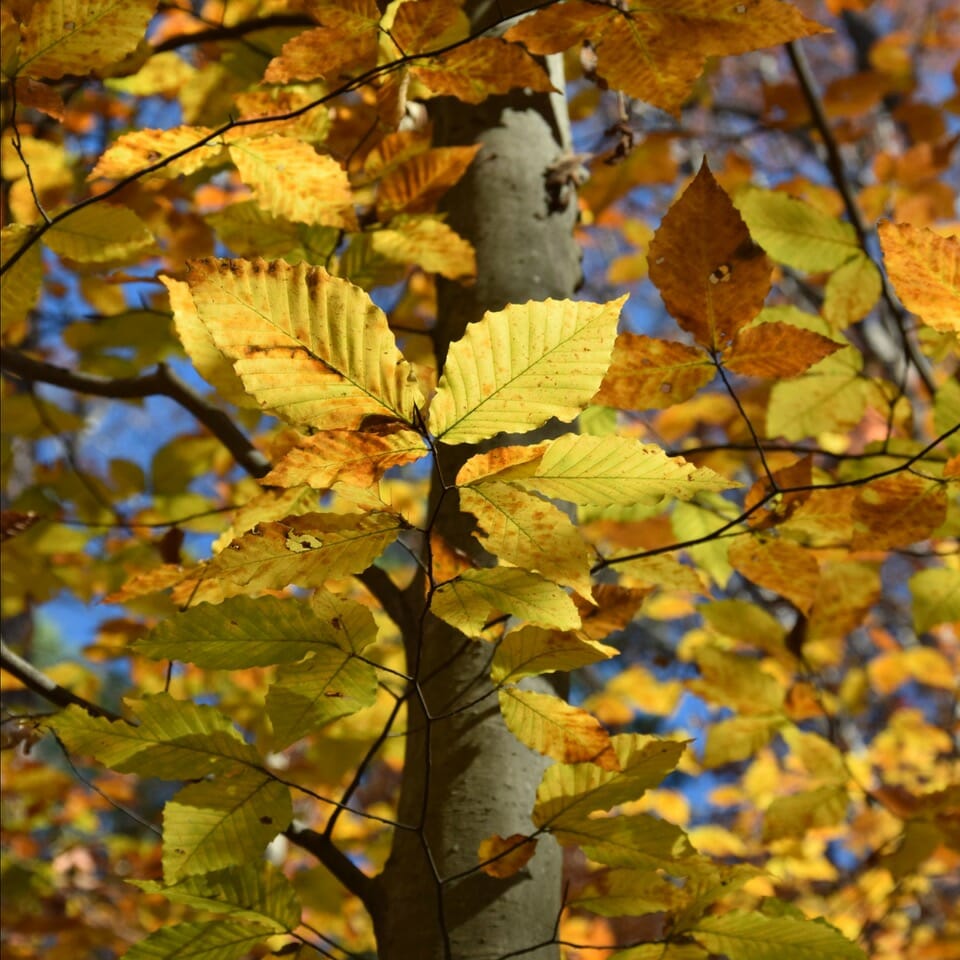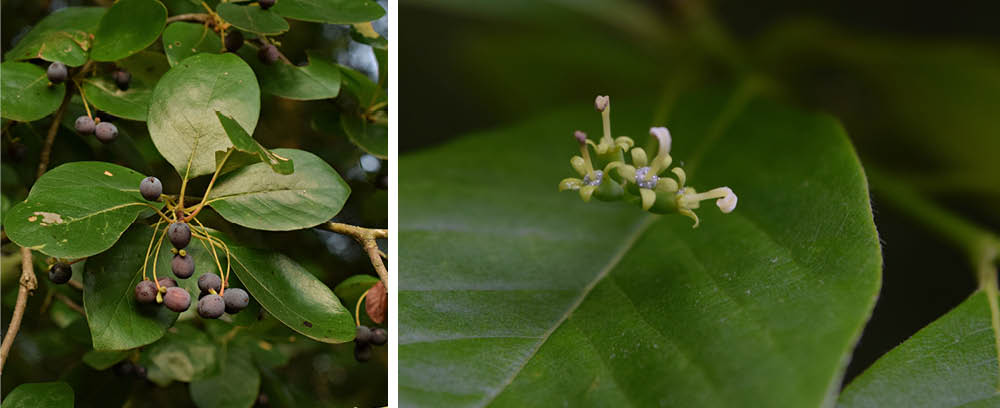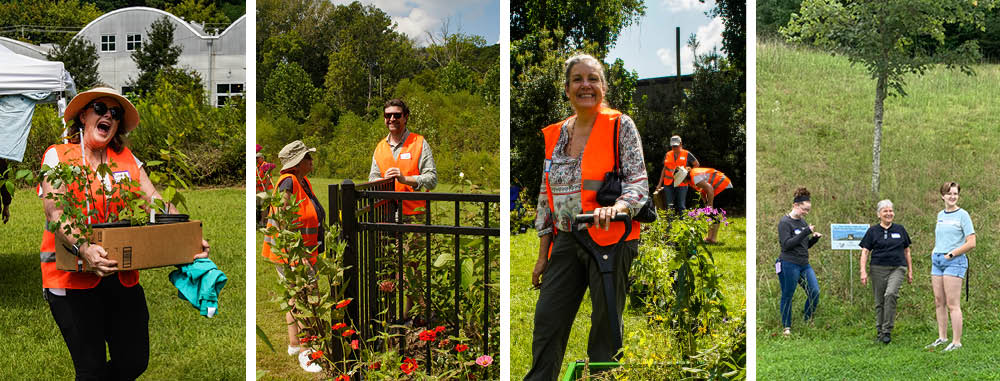
We'll soon bid farewell to our 2022 Plant of the year, American beech (Fagus grandifolia) as it shows its fall colors this month. See below about how to nominate your favorite native plant for 2023.
In This Issue ...
- Interested in serving on the GNPS State Board of Directors?
- Plant of the Year nominations open soon
- Spotlight on black gum
- Chapter News
State Board Openings
As we wrap up our third year with a governing State Board of Directors in place, we’d like to note that we can only maintain consistent direction if we rotate new members in each year. We’ve been blessed with many effective leaders on our current board who have set GNPS on a sure path toward becoming a leading conservation organization in Georgia. We need to transition in more new board members who will expand our work and vision.
If you're an active GNPS volunteer who has never considered being on the board, now's the time to ask why not! Or, if you're a new member who can commit to board responsibilities and active volunteering, you'd be perfect, too. Board meetings are typically remote, so you can be located in any part of the state.
We particularly need a board member with strong financial or accounting acumen who would be willing to serve as state Treasurer beginning in 2024. Our current Treasurer, Ron Smith, has laid a firm financial foundation crafting policies and procedures that will allow for a seamless transition. Ron wishes to work closely with the incoming Treasurer for a year to ensure this success.
We also are on the lookout for a state Secretary. Current Secretary Michele Buchanan has also gone the extra mile to set up outstanding recordkeeping procedures and policies for the state organization and Board. She wishes to train and mentor her successor during the coming year.
Additionally, we need a board member with legal expertise and another who is strongly interested in leading educational resources and initiatives. Even if you don’t fit any of the described openings, if you have time and talents that would benefit GNPS, or if you know someone who does, please reach out to us by emailing board@gnps.org.
Get Ready to Nominate Your Favorite Native Plant
Valerie Boss
The GNPS Plant of the Year (POY) program recognizes native plants that are of benefit to Georgia’s ecology and wildlife. If you are a GNPS member and have a native plant that you think is a true botanical treasure, please consider nominating it for POY 2023. Besides beauty, some characteristics to consider are adaptability, seasonal interest, fragrance, benefits to wildlife, and ease of propagation.
Members can only nominate one plant, and only current GNPS members can submit nominations. You should try logging into the GNPS web site to confirm that your membership is valid before attempting to submit. If the login fails, you can click on the “JOIN US” button to renew your membership.
POY 2023 nominations will open at 7 p.m. sharp on October 11th, 2022. Premature submissions will NOT be accepted. Submissions must include both the common and Latin names for the nominee, as well a reason why it would make a great GNPS POY. A sentence will suffice, but feel free to elaborate as much as you would like. We welcome information, especially regarding ecological significance or benefits to wildlife. Photos are encouraged, but not required.
You can find detailed nomination instructions on the GNPS website. Instructions will also be included in an email opening nominations on October 11th, and you will need to watch for that email (or check the post on the website that will be published at the same time) to get the link for submission. Like last year, you do not submit your nomination as email, but instead fill in a very short form.
All acceptable nominees must be:
- Native to Georgia (you can type USDA after the plant name in a Google search to look up its native distribution);
- Underutilized in gardens and landscapes and/or vital to the GA ecology;
- Adaptable enough to grow in most gardens;
- Not a previous GNPS Plant of the Year. Previous winners can be found on the on the table on the GNPS website.
Nominations will proceed until six acceptable nominees have been selected. As always, the first six submissions received will be given preference. However, the POY committee can pass over a plant if it is too similar to a previous submission (i.e., in the same genus, or having too similar an appearance and growth habit), or if it is only marginally eligible.
POY 2023 voting dates will be announced in October after nominees are finalized.
Previous POY T-shirts Still Available
As we start the selection process for the 2023 Plant of the Year, don’t forget that you can still order 2021 (fringetree) and 2022 (American beech) POY t-shirts from our digital print store in a variety of styles and colors. Styles include classic, slim fit, women’s, long-sleeve, and reverse design (main print on back). Note: when choosing shirt colors, the darker shirt colors may not show some of the darker ink colors as well.
Plant Spotlight: Black gum (Nyssa sylvatica)
Ellen Honeycutt

Black gum (Nyssa sylvatica) fruit and flowers.
The tree known as black gum (Nyssa sylvatica) has such a modest look most of the year that it seems to go unnoticed by many. Also commonly known as tupelo or sour gum, the leaves are simple in shape, not lobed or compound, and they are alternate along the stem – an arrangement common to many trees. The flowers appear in May after the glossy leaves have already emerged. Their modest appearance is almost hidden by the foliage and certainly overlooked by many a human (although the bees notice them).
It is fall when black gum really shines, catching the attention of humans and providing abundant fruit for numerous birds. It is one of the first trees to transition to fall foliage, although most often it starts by sporting a few bright red leaves rather than a complete transition. Leaf spot is common on older leaves but it doesn’t prevent it the leaves from turning their brilliant shades of orange, red, and even purple.
While this tree is quite tolerant of damp places, you can also find and grow it in drier areas, making this one of our most adaptable native trees. It has statewide distribution and is found in all 5 ecoregions of Georgia. It is related to the tree known for tupelo honey, Nyssa ogeche, which grows in south Georgia. Black gum also offers a sweet treat to both native bees and honeybees.
A number of cultivars have been developed, especially ones with reliably red fall color – ‘Wildfire’ was one of the earliest ones – helping to ensure that this tree is more available to the public. Black gum is primarily dioecious, having male and female flowers mostly on separate plants with a few perfect flowers on each plant. Planting more than one helps to ensure better fruit set but don’t be surprised to find that there might already be a black gum near you that will provide cross-pollination support.
Fall is a great time to plant native trees in Georgia. Consider if black gum might be a good choice for your landscape, helping you to bring more ecological support to residential areas. Mature height is up to 50 feet and width to 25 feet, making this a good choice for many home areas.

Black gum (Nyssa sylvatica) turning its characteristic fall colors.
Chapter News

Smiling faces around the state include volunteers at the Intown Atlanta Native Plant Swap and Share (left 3 photos) and North Georgia Mountains volunteers installing a chapter sign at a new planting site (right photo).
Augusta's River Region Chapter
Augusta's River Region Chapter is having a plant sale on Saturday, October 15th. It will be held at Reed Creek Nature Park and Interpretive Center, 3820 Park Lane in Martinez, Georgia, from 9:30 a.m. to 2:30 p.m. There will be a nice variety of plants, including some from the rescue the chapter held in August. We will have lots of 1-gallon, 2-gallon, and 3-gallon sizes. Updates will be posted on our Facebook page.
The chapter will have at least two fall/early winter rescues. Please contact Mary Caddell if you are interested in being on the contact list to participate in them.
Fringed Campion Chapter
The Fringed Campion Chapter has several upcoming events.
- Oct. 8 from 9 a.m. to 1 p.m. at Wesleyan Market in Macon: Native Plant Sale.
- Oct. 22 at 9 a.m.: Invasive Plant Removal Work Day at Wesleyan College Arboretum.
- Nov. 5 at 10 a.m.: Annual General Meeting at Willet Science Center Auditorium, Mercer University. The guest speaker topic will be Regenerative Horticulture Techniques. Our annual membership meeting will follow.
For more information check the events link on our Facebook page or email us.
North Georgia Mountains Chapter
The September meeting of the North Georgia Mountains chapter featured a presentation by Becky Griffin with UGA on the topic of Pollinators You Need to Know, featuring bumblebees, gray hairstreak butterflies, and great black wasps, and the native plants that they interact with. She is also the coordinator of the Great Georgia Pollinator Census, conducted in August. Contributing to that also opens one’s eyes to the smaller parts of the world around us.
After the meeting a chapter sign was installed at Young Harris College at a site where a group of students, under the tutelage of the chapter’s vice president Jonathan Micancin, will be installing a native population of plants along a previously mowed embankment.
Our October meeting (Saturday the 8th, 10 am, room 107 of the Maxwell Center at Young Harris College) will have a presentation on the process of Restoring Georgia’s Native Grasslands by Zachary Wood. He has a broad range of involvement in managing grasslands, in Georgia, Alabama, and South Carolina, and will let us know about some of the steps involved in reestablishing endangered plants.
There are plant sales being held by different organizations, probably throughout the state, which helps because it is best to plant particularly shrubs and trees when they are relatively dormant. And remember to enjoy the leaf peeping!
Coastal Plain Chapter
This month, the Coastal Plain Chapter will co-sponsor two educational events with Gaskins Forest Education Center, located at 3359 Moore Sawmill Rd, Alapaha, Georgia. There is no charge for either program, and they can be counted as an elective for the Certificate in Native Plants program of the State Botanical Garden of Georgia.
Native Grasses Workshop —Sat., Oct. 22, 9 a.m. - 3 p.m.
Dr. Richard Carter will lead a native grasses workshop at the Gaskins Forest Education Center. Weather permitting, the class will work on identifying grasses in the field. After lunch, the class will survey diagnostic features in the lab. The class will cover characteristics useful in distinguishing grasses from other graminoids, including sedges and rushes. Other topics to be covered are identification of invasive grass species, recent changes in nomenclature of grasses, and recommendations on references and equipment useful in identifying grasses. A field house is available for participants to stay overnight. To register, contact Heather Brasell.
Groundcover Restoration Workshop —Sat., Oct. 29, 9 a.m. - 1 p.m.
Heather Brasell will lead the ground restoration field day at the Gaskins Forest Education Center. The class will visit a variety of sites to compare and contrast groundcover restoration projects and management practices, including managing invasive plant species. Focus will be on management decisions rather than on identifying specific plants. We’ll discuss challenges, successes, and ways to do it better next time. Habitats include minimum understory management (thin and burn) on different sites, economy understory restoration (thin and burn with limited use of supplemental seeds), high-quality seed mix for pollinator garden, conversion from turf grass to meadow, and rehabilitating a wetland area. A field house is available for participants to stay overnight. To register, contact Heather Brasell.
West Georgia Chapter
The West Georgia Chapter will host Rose Guerra on Tuesday, October 18th. Rose is a naturalist and environmental educator. She will present Gardening for Bats (timely with Halloween just around the corner!). Faced with multiple challenges for survival including the “white nose syndrome,” bats need our help. Come find out what you can do to support these vital creatures.
Registration opens at 6:30 p.m., with the presentation beginning at 7:00. Join us at the Carroll County Ag Center, 900 Newnan Road, Carrollton, GA
North Metro Chapter
Our fall chapter plant sale will be held on Saturday, October 15th from 10 a.m. to 2 p.m. at Old Rucker Farm in Alpharetta. We are once again partnering with the Alpharetta Community Agriculture Program for a joint sale where they will sell veggie starts. We will have a selection of donated and purchased native plants. In addition, the vendor Cottage Garden Natives will bring a selection to sell. Parking will be onsite and also via a free shuttle from Wills Park (select and purchase your plants and then bring your car back to pick them up). For those of you who pre-ordered plants, an email will instruct you about pick-up arrangements.
Intown Atlanta Chapter
We want to give a huge thanks to everyone who volunteered or participated in our first ever Native Plant Swap & Share as part of our second Annual Meeting. Over 85 people joined us at Zonolite park and almost 600 plants were swapped and shared! Our growing Intown Atlanta native plant community continues to restore habitat and preserving biodiversity by adding native plants where we live. We look forward to many more activities in the coming year! |